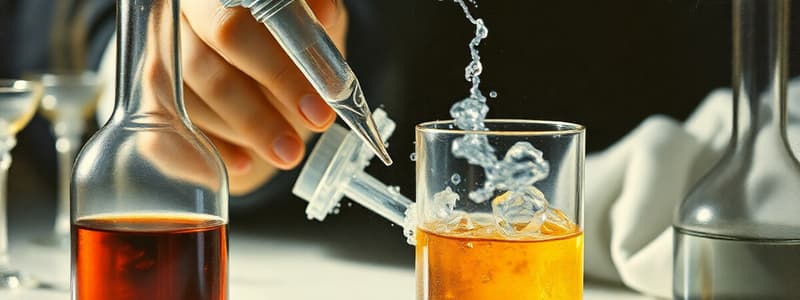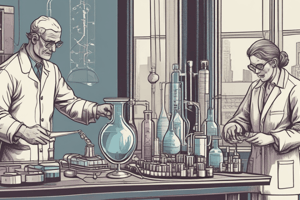Podcast
Questions and Answers
What does the retention time in chromatography represent?
What does the retention time in chromatography represent?
- The amount of sample injected into the column
- The temperature of the gas during the reaction
- The time taken for a molecule to drain out of the column (correct)
- The pressure of the gas used in the separation process
Which statement accurately describes gas chromatography?
Which statement accurately describes gas chromatography?
- It uses a liquid solvent as the mobile phase.
- It employs a solid, powdered substance as the stationary phase. (correct)
- It can separate both volatile and non-volatile liquids.
- It is mainly used for analyzing solid samples.
What is the primary advantage of using GC-MS over traditional gas chromatography?
What is the primary advantage of using GC-MS over traditional gas chromatography?
- It combines gas chromatography and liquid chromatography techniques.
- It allows for the separation of non-volatile substances.
- It requires less sample material.
- It produces faster and more accurate results for molecule analysis. (correct)
What component is directly fed into the mass spectrometer after gas chromatography?
What component is directly fed into the mass spectrometer after gas chromatography?
Which of the following is NOT a characteristic of gas chromatography?
Which of the following is NOT a characteristic of gas chromatography?
What is the primary purpose of chromatography?
What is the primary purpose of chromatography?
Which phase is considered the stationary phase in chromatography?
Which phase is considered the stationary phase in chromatography?
What does a higher Rf value indicate about a component in chromatography?
What does a higher Rf value indicate about a component in chromatography?
In Thin-Layer Chromatography, which method can be used to visualize the chemical traces?
In Thin-Layer Chromatography, which method can be used to visualize the chemical traces?
In Column Chromatography, what acts as the stationary phase?
In Column Chromatography, what acts as the stationary phase?
Which factors determine how far a molecule moves with the mobile phase in chromatography?
Which factors determine how far a molecule moves with the mobile phase in chromatography?
What role does the mobile phase play in chromatography?
What role does the mobile phase play in chromatography?
What happens when a component molecule has a high affinity for the stationary phase?
What happens when a component molecule has a high affinity for the stationary phase?
What is the primary function of the stationary phase in gas chromatography?
What is the primary function of the stationary phase in gas chromatography?
In the gas chromatography process, what does a higher retention time typically indicate about a molecule?
In the gas chromatography process, what does a higher retention time typically indicate about a molecule?
What is a significant advantage of the GC-MS technique over conventional gas chromatography?
What is a significant advantage of the GC-MS technique over conventional gas chromatography?
Which statement best describes how components are identified in the GC-MS process?
Which statement best describes how components are identified in the GC-MS process?
What role does high-pressure gas play in gas chromatography?
What role does high-pressure gas play in gas chromatography?
What is the role of the mobile phase in chromatography?
What is the role of the mobile phase in chromatography?
Which factor influences how far a molecule will travel with the mobile phase?
Which factor influences how far a molecule will travel with the mobile phase?
What is an Rf value?
What is an Rf value?
In Thin-Layer Chromatography, which method is used to make chemical traces visible?
In Thin-Layer Chromatography, which method is used to make chemical traces visible?
What is the primary function of the stationary phase in chromatography?
What is the primary function of the stationary phase in chromatography?
Which best describes column chromatography?
Which best describes column chromatography?
Why is it important to dry the Thin-Layer Chromatography plate in a fume cupboard?
Why is it important to dry the Thin-Layer Chromatography plate in a fume cupboard?
What happens to a molecule with high affinity for the stationary phase during chromatography?
What happens to a molecule with high affinity for the stationary phase during chromatography?
Flashcards are hidden until you start studying
Study Notes
Chromatography
- Chromatography is an analytical technique that can separate and identify the component molecules of a mixture.
- It involves a mobile phase and a stationary phase.
- The mobile phase allows the molecules to move over or through the stationary phase.
- The mobile phase can be a liquid or a gas depending on the type of chromatography being carried out.
- The stationary phase has an affinity for the molecules in the mixture being analyzed.
- The greater the affinity of the molecule to the stationary phase, the shorter the distance it moves with the mobile phase.
- Rf values are calculated by comparing the distance moved by the mobile phase and the molecule.
Types of Chromatography
- Thin-Layer Chromatography (TLC): uses a metal plate coated with a thin layer of silica as the stationary phase. A solvent moves up the plate as the mobile phase.
- Column Chromatography: uses a vertical column packed with a solid powdered substance as the stationary phase. A solvent containing the mixture being analyzed is added and moves down the column as the mobile phase.
- Gas Chromatography (GC): uses a thin tube packed with a solid powdered substance as the stationary phase. A high-pressure gas is passed through this tube as the mobile phase. This method is used to separate mixtures of volatile liquids.
- GC-MS: a combination of gas chromatography and mass spectrometry, which produces more accurate results for molecule analysis and identification.
Chromatography Techniques
- Chromatography is an analytical method for separating and identifying components of a mixture.
- It utilizes a mobile phase (liquid or gas) and a stationary phase.
- The mobile phase carries molecules through the stationary phase.
- Molecules with greater affinity for the stationary phase travel slower.
- The distance traveled by a molecule relative to the mobile phase is its Rf value.
Thin-Layer Chromatography (TLC)
- A metal plate coated with silica serves as the stationary phase.
- A solvent is used as the mobile phase, moving up the plate.
- The plate is dried to remove toxic fumes.
- Traces are visualized using a UV lamp, or a developing agent like iodine.
- Rf values are calculated to identify components.
Column Chromatography
- A vertical column packed with a solid powder acts as the stationary phase.
- A solvent containing the mixture is added and moves down the column.
- Molecules with different affinities for the stationary phase drain out at differing times.
- The time taken to drain is the retention time, allowing molecule identification.
Gas Chromatography (GC)
- A thin tube packed with a solid substance is used as the stationary phase.
- A high-pressure gas acts as the mobile phase through the tube.
- Separates volatile liquids fed into the GC machine as vapors.
- Each component molecule has a recorded retention time, enabling identification.
GC-MS
- Combines gas chromatography with mass spectrometry (GC-MS) for advanced analysis.
- Molecules are first separated using gas chromatography.
- Each molecule is then fed into a mass spectrometer for detailed identification.
- Faster and more precise than traditional methods for molecule analysis.
Studying That Suits You
Use AI to generate personalized quizzes and flashcards to suit your learning preferences.




